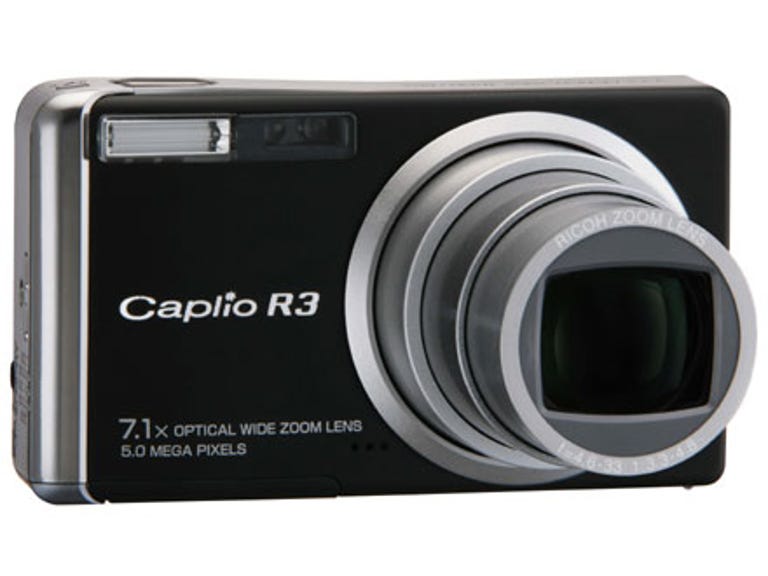 Why You Can Trust CNET
Why You Can Trust CNET Ricoh Caplio R3 review: Ricoh Caplio R3
Ricoh's Caplio R3 offers excellent zoom and quick photo taking opportunities.
Design
The Caplio R3 is a slickly designed camera with stark metallic lines in a very small (95.0 x 26.0 x 53.0mm) and light (around 160g with battery) casing. The top of the camera contains the power button, a small shot button and a very small button that controls the camera's vibration correction function. The rear houses all the camera's major controls, including a vertical zoom control and the 2.5 inch LCD. There's no optical viewfinder. One common issue with smaller cameras like the R3 is that the controls can be somewhat tightly packed together, and it's a pitfall that the R3 doesn't quite escape. Those with larger hands (or less manual dexterity) could find some of the R3's controls a little tricky to deal with.
The Good
The Bad
The Bottom Line
The R3 uses a retracted lens -- in fact, it's a very retracted lens, using what Ricoh calls its double retracting lens system. When you first power up the camera you'll get something of a shock, partly because it's got a rather noisy mechanism, but mostly because the lens shoots out to around three times the length of the camera body itself. It almost gives the impression that you could use the R3 as some kind of crude hammer. (Note: CNET.com.au does not suggest that you should use the R3 as a hammer unless lives are at stake. You will assuredly break the camera doing so.)
If you've ever laid awake at night wondering whatever happened to those leather patches that adorned university lecturer's jacket elbows in the 1970's, then you probably need serious help. That having been said, you can wonder no more, as clearly the patches have been re-sewn to make up the Caplio R3's carrying pouch. It's an odd contrast in styles, given the sleek metallic lines of the R3 camera itself, to put it into a dark brown carrying case.
Features
The R3 is an effective 5.13 megapixel camera with an impressive wide angle 28mm lens capable of 7.1x optical zoom. There's no digital zoom on the R3 whatsoever. It's not massively well equipped in the internal storage stakes, with only 26MB of internal storage. That's good enough for only 13 pictures at highest (2592 x 1944) resolution. It'll take SD or MMC cards up to 1GB; we'd suggest that some kind of additional storage would be a mandatory purchase if you're considering the R3.
Smaller cameras are ever more prone to handshakes, and the classical solution to this has been to stick the camera onto a tripod. That's still an option for the R3, but it's also possessed of some inbuilt vibration correction functionality that's controlled via a very small button on the top of the camera. It's not perfect -- those with severe drinking problems could certainly give it a run for its money -- but it's a nice feature to have.
Performance
Shooting with the R3 was simple and suprisingly quick, although the price you pay for that is in somewhat noisy operation, especially if you need to quickly zoom in on a subject or wait for the macro shooting focus to fully adjust. It's not at a worrying level, but it is noticeable.
The key to getting good shots out of the R3 quickly became apparent, and that's to select the correct shooting modes. That might sound rather obvious, and true for every camera, but in the R3's case the difference between shots taken at full auto -- which ranged from the ordinary to very good -- and shots taken with the correct settings was quite marked. Of course, there will be times when you just want to quickly snap an automatic shot, and in some ways it's hard to recommend the R3 for this purpose. That's more of a function of its better shooting modes being very good than it being particulary deficient in auto mode, however.
The menu structures in the R3 aren't the most consumer-friendly we've seen, although the most commonly used functions are mapped around the five-way selector on the bottom right of the camera face. It's markedly not a camera that you can just pick up and shoot with, but patience and practise will bear good rewards.
The R3's display is nice and bright -- and the level of brightness can be adjusted for bright days, which is a good feature -- although we did notice some odd light patterns playing across the R3's LCD display while shooting, especially if there were light sources directly above the camera itself. They didn't affect the eventual shots we were taking, but were somewhat distracting while trying to correctly frame shots.


